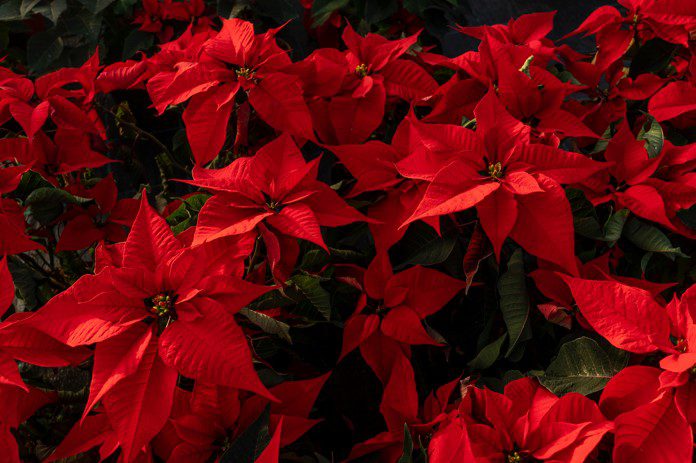Poinsettia
Poinsettia is Christmas in a pot! Legend has it that a young Mexican girl had nothing else to bring to the altar at Christmas so she went with what she could afford – some plants from the roadside which then sprouted red blooms.
These blooms are actually leaves, called bracts, brightly colored to attract pollinators.
Poinsettia breeders now cultivate bracts that are creamy and pink but I think vibrant red leaves make the perfect choice for the festive season.
It’s part of the big euphorbia family and a native of Mexico, which means it really doesn’t like the cold.
Poinsettia Health Hazard
You might think twice about bringing a poinsettia colorful houseplant to brighten the holiday season for a friend.
People with latex allergies can have severe reactions to poinsettia. Consider bringing a plant into a hospital if you have allergies to latex gloves.
The ornamental poinsettia (Euphorbia Pulcherrima) is a member of the same plant family as the Brazilian rubber tree, which is extracted from latex.
An allergic reaction can be triggered by direct contact with white milky sap from broken poinsettia leaves or when pruning the plants.
The symptoms can include rash and sneezing and tightness in your throat, difficulty breathing, and hives. In rare instances, it could even be fatal.
Dr. Peter M. Ranta of the Medical College of Georgia, Augusta, advised caution, particularly if plants are damaged or crushed.
Prevention of infection
According to The Lancet, a British medical journal, millions of office workers could avoid illness by installing germ-killing lighting in their ventilation systems.
Montreal researchers at McGill University found that central air conditioning systems almost always contain microbes such as bacteria, fungi, and protozoa, associated with respiratory disease, skin irritation, and congestion.
Researchers found that UV germicidal radiation equipment could kill 99 percent of microbes living in cooling coils and drip pans.
Researchers estimated that if irradiation systems could be used in all North American offices, 4 million employees would experience work-related symptoms. This would save employers $5 billion to $75 billion.
Poinsettia Care
The holidays are almost over. But with proper care, your poinsettia plants may be enjoyed throughout the year. Gordy Milligan of The Garden Factory in Gates offers the following tips:
December through January: The plants need very little care this time of the year. Just water the poinsettias and enjoy.
February through March: Fertilize at half-strength – half a tablespoon of Miracle-Gro or similar fertilizer per gallon of water – every third watering.
Milligan says that when the flower bracts start to show signs of fading, it is time to put the plant in dormancy. Heavily prune the plant back to about 8 inches tall, leaving one to two leaves per branch.
After pruning, decrease the watering, so the top inch of soil is dry between watering.
April through June: By mid-April, increase the watering frequency and begin fertilization with one tablespoon of fertilizer per gallon of water once a month.
By late May, the plant should be growing vigorously. In June, it should be warm enough to plant your poinsettia outside.
July through September: Fertilize your poinsettia at half-strength every other watering. In mid-July, pinch back the branches about 2 to 3 inches.
Check your plant for insects before bringing it indoors at the end of the summer. In September, your plant will be triggered to flower because it will sense the days are growing shorter.
The light cycle has to be very strict once it is brought indoors. Isolate the plant in a closet or unused box at night because exposure to a light bulb will disrupt the flowering cycle.
In the morning, bring the plant out and place it in a sunny window.
October through November: Keep watering and fertilizing as usual. Make sure the plant is not too cold during the long nights. The temperature should not dip below 45 degrees.
By mid-November, the bracts should begin to develop. Enjoy it for the holiday season.
Here are some tips for maintaining your poinsettia healthy all winter:
- Avoid sudden temperature changes. Cover them if you carry them outdoors, and the temperature is near or below freezing.
- Place in a bright window.
- Keep the soil moist.
- Don’t let them get dry, and don’t let them get waterlogged.
- Make sure water doesn’t pool in their foil wraps.
- Standing water will kill them as surely as freezing temperatures.























